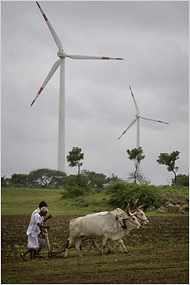ANN ARBOR, MI — We’re heading into the final day of the 2010 Net Impact Conference.
By all accounts, Stonyfield’s CEO and Founder Gary Hirshberg opened the day by receiving a standing ovation from the ginned up Net Impact crowd. This reporter did not make it to the plenary, but Hirshberg’s book Stirring It Up is a great read on the firm’s integrated sustainability journey.
The session at hand looks at how natural gas can serve as a bridge to a lower carbon future. With half the emissions factor of its more pernicious fossil fuel cousin, coal, and significant reserves in the US, I am eager to see how the panel addresses its role in the energy mix. There’s a rising chorus supporting natural gas consumption in the US given the innovation that has emerged in the past decade to market it more efficiently. However, we know very little about the environmental risks and while natural gas supporters argue the national security merits of the energy source, if we don’t understand the potential contaminant risk, domestic security could be threatened.
We have industry, environmental advocacy and law represented in the room, so the table is set for a robust debate.
This is my final session, so before I get into the substance, I want to congratulate the team at Net Impact for yet another superb conference.
OK, here’s who we have this morning:
Dusty Horwitt, Senior Counsel, Environmental Working Group
Knut Simonsen, VP, Strategy and Corporate Development, DTE Energy
Luke Miller, Miller Energy
Donnan Steele, Associate Principal, McKinsey & Company
David Nash, Environmental and Energy Attorney (moderator)
Donnan Steele, Associate Principal, McKinsey & Company — An Intro to Natural Gas in the US
- US has added nearly 60 years of domestic gas capacity, mainly due to new shale discovery
- Natural gas demand and use have dropped post recession
- Forecasters now believe we have 100 years of natural gas supply in the US
- Marcellus Shale is an example of an “unconventional” natural gas resource
- Renewable trends have pushed natural gas production down — a perverse incentive?

How sustainable is Hydrological Fracturing (fraking) for natural gas extraction? — Donnan Steele
- Hydrological Fracturing is incredibly water intensive
- Environmental impacts of fraking are opaque
Luke Miller, Miller Energy
- EPA initially said it was OK
- Now that we are going deeper and using more water, questions linger
- Industry supporting EPA study in progress
Knut Simonsen, VP, Strategy and Corporate Development, DTE Energy
- There’s not yet any scientific correlation between hydrological fracturing and environmental risk (e.g., earthquakes)
- But offshore extraction costs are large and impacts are not entirely known
- A solvable problem
- New York State has a very undeveloped regulatory environment for natural gas extraction because fraking is such a recent phenomenon
- The forecast is positive on how natural gas can reduce the carbon intensity of the US energy mix as older coal-fired plants get shutdown
Dusty Horwitt, Senior Counsel, Environmental Working Group — on environmental risk
- Agrees that environmental questions have not been answered
- Not all chemicals involved in fraking are safe
- Water flows at 100,000 pounds per square inch in fraking (10 x more powerful than a firehouse)
- Industry uses toxic chemicals in fraking (e.g., Benzine)
- Very little investigation done on water contamination in fraking; no site level study conducted by EPA
- We have to study these chemical impacts in the fraking fluid and the diesel fuel that runs the equipments used in the pumping at extraction sites
Final Thoughts — Knut Simonsen
- Natural gas will be a bridge fuel for 30-40 years, bur probably not much beyond
- Wind and solar capacity will continue to grow as R&D improves especially in developing economies
Final Thoughts — Dusty Horwitt
- Environmental Working Group is unconvinced natural gas will be a less carbon intensive bridge fuel
- Not sure there is a material reduction in carbon intensity in contrast to coal-fired electricity plants
- More study is required





Excellent! Great article, I already saved it to my favourite,